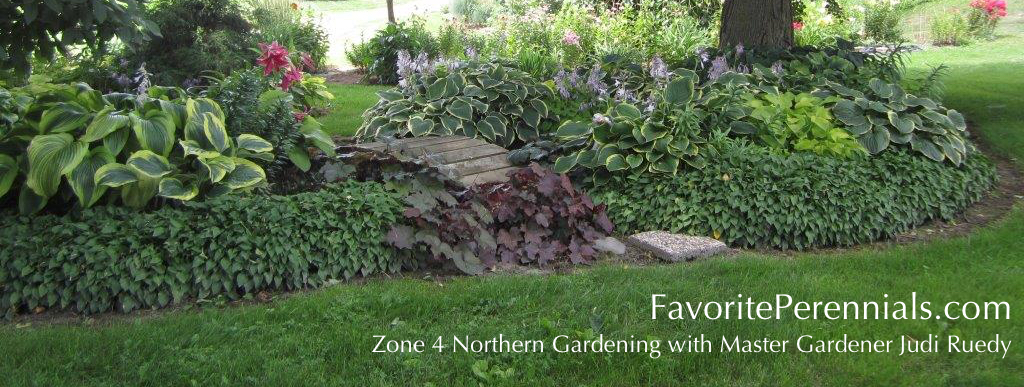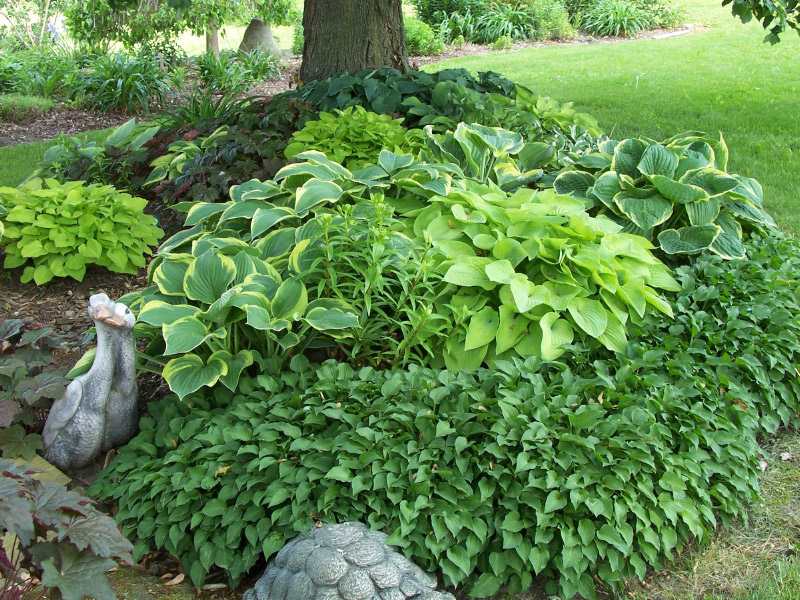Design Ideas for Hosta Gardens
Create stunning Hosta gardens with easy to care for shade loving plants. Learn how to choose Hosta varieties that complement each other with a variety of shapes, colors, and textures.
Below are some pictures of my shade garden taken recently, so I invite you to come with me and take a virtual tour of a few of my perennial beds.
Over the years each of the beds have changed as I have moved plants around and gotten a better idea of how large and tall some of the Hosta varieties can become.
Design Ideas For Hosta Gardens
Click on each of the photos for larger images.

The first photo shows a border of Tiny Tears Hosta. Far left front is Golden Scepter. Then the geese, Francee, and Green Wedge, and Christmas Tree. Surrounding the tree is Valentine Lace.

This is the same bed as the picture above, from a different angle. The front border is Tiny Tears. Front center is Christmas Tree. On the left is Green Wedge and the back right is Francee.

This is an early spring picture of the planting area right outside our house. When I look out the door each morning, I feel a sense of relaxation and even on a hot day the Hostas look cool.
There is so much you can do with just one type of perennial such as a Hosta.
There is a major variety of Colors and Textures with all of these different Hosta and then interplanted with white or pink Vista Petunias and white impatiens in pots.Or, for quite a different look, Hardy Lilies such as Siberia or Star Gazer for a bright burst of color in late July.
I have put a “Raspberry Blast” Wave Petunias in one of the large containers as well now I use Vista Bubblegum Pink Petunias in some of the large pots for something different, but mostly I use white as they practically glow and light up the evening.

In this hosta garden left to right are Regal Splendor, Abiqua Drinking Gourd, Montana ‘Aureomarginata’, and a border of Stiletto. Hostas add Elegance to any plantings.
The Regal Splendor Hosta I moved from another area this spring, that was getting overgrown and it is in a better place here by the gazebo. But, every time you move a Hosta plant it sets the growth back for a year as it has to acclimate itself to the new growing area and conditions and so by next spring, it will be 4 to 6 inches taller than it is now.
The large Montana ’Aureomarginata’ looks pristine with the old wagon wheel backdrop.
The Abiqua Drinking Gourd looks a bit lost in the picture, but seeing it here you can see the heavily corrugated and cupped leaves.
The Stiletto just keep growing wider each year and next year need a hair cut or they will take over the narrow parts of the bed. I will then continue on with the border around the back of the planting area around the gazebo.
This is another Hosta garden planting area on the back steps of our house that has a steep slope. The Hosta on the left is Krossa Regal and the light green is a border of Kabitan.
I first saw Kabitan used as a border in a Paul Aden Book a long time ago. I knew I wanted it from the start, but that was almost before they were for sale. So, I was patient and when I did purchase one, I had to wait for it to multiply. This little Hosta too has stoloniferous roots that spread underground and so makes for many plants once it gets established.
It is a lightly substanced leaf on it and so is an attraction for slugs. They stay bright throughout the summer, but fade from these brilliant chartreuse colors later in the summer.
I have changed the direction of the “border” in the past couple of years so that it isn’t in one long line, but in a few different sections, but still the repetitive plants and bright spots in this planting area.



Wow, what a boost to see after all this white. The pictures are wonderful but don’t do your gardens justice……
On one hand, I can’t wait… on the other or I should say my body can wait.
Thank you! Yes, I like to look at them in the winter too, and wonder, will they actually be that nice once again?
I wonder about my body too! Hope it all comes along slowly.
Dear Judi….Really enjoyed your last posting on hostas. Looking forward to more articles on hostas…Thank You…Hostaholic Robert
Hi Robert, I guess I missed this post from you back in March. Glad you like the website. Judi
Looking at your hosta gardens makes me so excited for spring!! Here in minnesota we are just heading into winter and I already have spring fever!!!
Hi Mary,
I am willing to let the Hostas rest a couple more months and since we live in MN and WI that will have to happen! Thank yo for looking at my website!
I had signed up for your news letter about 9 months ago but did not hear from you. So what a pleasant surprise to get this email from you today.
I grew up on a farm in northwest Iowa so seeing your plants on an actual farm yard brings back fond memories.
Do you have any other ideas for other Hosta varieties that can be used for a border? I just love the way your baby tears set off one of your island beds. I am needing to have a variety that is a little smaller as my beds are not as large as yours.
Thank you very much,
Karen
Hi Karen,
Glad you liked the newsletter. I haven’t been writing very much for awhile as too many things taking my time away from the newsletter.
The Baby Tears that are around the island bed have been there for about 15 years or more, so they are larger in size than say a 5 year old planting would be. They are one of the nicest miniature hostas and just make a nice clumping shape and so great for a border. They are stoloniferous. (spreads from the roots like quack grass does) and so grows
outward in all directions. The other miniature that is real nice is Blue Mouse Ears. they also multiply quite fast, but the clump gets larger each year. They don’t get more than about 4 inches tall, but spread out readily. I find that both of these varieties are quite hardy. Another nice border is Dew Drop, but that is a taller size of maybe 10 inches or so. I talk about that one in the article I wrote on perennial borders for flower beds.
You don’t have to have a border around the whole bed either. You can stop it at a larger plant or at a large rock and go just partway around. I did that with the Baby Tears as when it was originally planted, I didn’t have enough plants to go around the whole bed. Hope this has helped you out! Happy Gardening, Judi
[…] Download Image More @ https://www.favoriteperennials.com […]
How do you keep the grass from growing in between the hosta
Hello Teresa,
To keep the grass from growing between hostas or other perennials, I use a mulch of chopped leaves that I put on in the fall when I am bagging them. It takes longer to clean up the lawn in the fall, but then it is all done for spring. And, I don’t have to spend money on wood chips. There is also some grass that gets mowed and added to the leaves but that seems to be okay as that breaks down too over time into the soil.
Another thing to do is to use wood chips. (depends on how many areas you are covering and how many perennial beds! I like a sherdded bark if I use it and cedar if you can find it. Keep any mulch about 2″ away from the crown of the plant.
I also take an old steak knife out with me when I walk around the yard and cut out clumps of grass or weeds with that. I can get down under most weeds (not dandelions though) and get most of the roots.
And, still, another way is to use a herbicide, like glysophate being careful not to get any on plants you want to keep, as it will kill anything green. I use a small spray bottle and go right in on the weed and grass carefully and not when it is windy.
So, I hope I have helped you with the question! Thank you for asking and for checking out my website! Happy Gardening,Judi
How do you keep the slugs at bay?
Thank you for finding and visiting my website. That is quite a question! Slugs and other “critters” are always a summertime problem with any perennials.
The thing I have found that “seems” to work the best, is in the fall I bag all the lawn leaves and pine needles and put them on the beds.
First I cut down the Hostas and other perennials that are there and then spread the mulch over the whole bed keeping it away as much as I can around the clump and stems.
I will start this maybe mid-October, (zone 4) and it will last for a couple of years. The mulch is nice to walk on and soft too. There is nothing in this mulch that slugs like. (not like the coolness of wood chips underneath) I got this idea from a garden writer/author in Minnesota and his name is Don Engebretson and has written a number of books on gardening for Minnesota and Wisconsin. The idea seems to work. Also, the leaf mulch is good for the soil as it slowly decomposes.
I have also used Deadline pellets and that seems to help some, but haven’t used them since starting the leaf mulch. They are best put on early April, and again early October. (again for my climate here) This is when the slugs are emerging and also laying their eggs in the fall.
Another thing I have done in the past….I had a border around the bed with the round stone stepping stones that you purchase at a place like Menards. I would go out each day and lift them up and find many slugs under them which I would then dispose of. I don’t think you can ever get them all! They are just in the environment, but hope this helps with your gardening problem!
Thank you for asking, and Happy Gardening! Judi